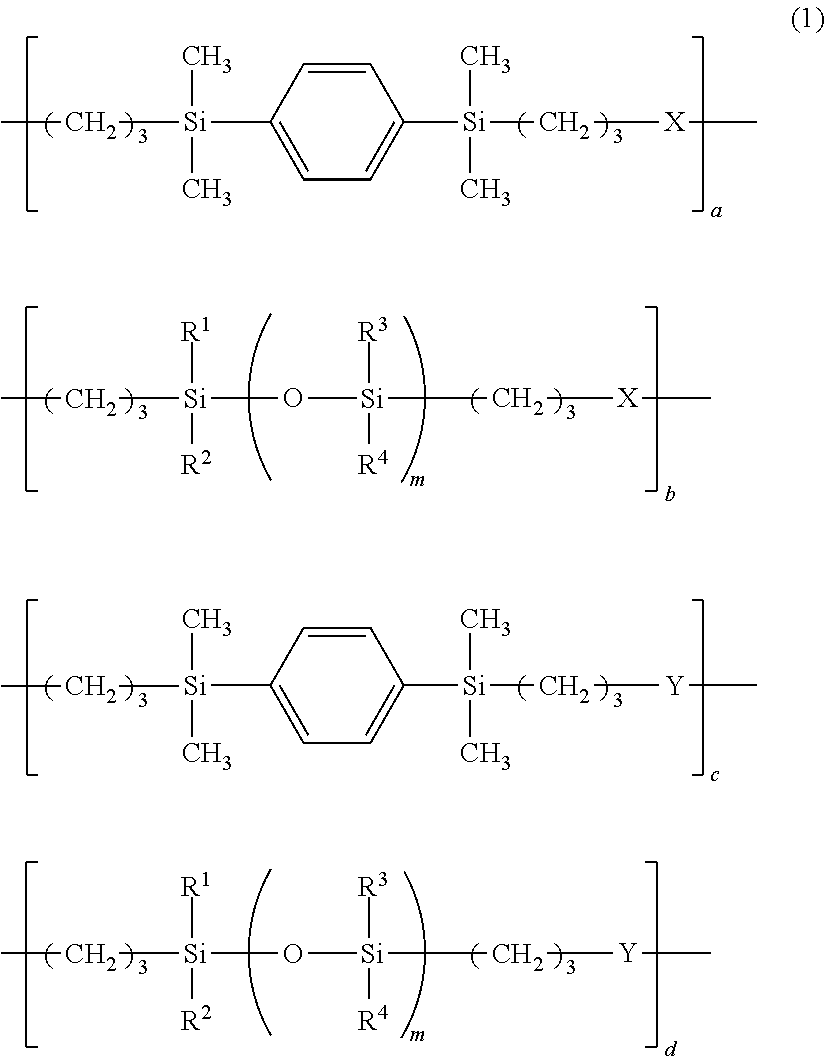Adhesive composition and adhesive dry film
- Summary
- Abstract
- Description
- Claims
- Application Information
AI Technical Summary
Benefits of technology
Problems solved by technology
Method used
Image
Examples
synthesis example 1
[0107]In a 5-L flask equipped with a stirrer, thermometer, nitrogen purge line and reflux condenser, the compound (M-1) (396.9 g) and the compound (M-4) (45.0 g) were dissolved in toluene (1,875 g). The compound (M-5) (949.6 g) and the compound (M-6) (6.1 g) were then added, followed by heating to 60° C. Subsequently, a carbon-supported platinum catalyst (5 wt %) (2.2 g) was charged. After the internal reaction temperature was confirmed to have arisen to 65 to 67° C., the reaction mixture was heated to 90° C. over 3 hours. The reaction mixture was then allowed to cool back to 60° C., at which a fresh supply (2.2 g) of the carbon-supported platinum catalyst (5 wt %) was charged, followed by dropwise addition of the compound (M-7) (107.3 g) into the flask over 1 hour. At that time, the internal temperature of the flask arose to 78° C. After completion of the dropwise addition, the reaction mixture was subjected to aging at 90° C. for 3 hours. The reaction mixture was then allowed to c...
synthesis example 2
[0109]In a 5-L flask equipped with a stirrer, thermometer, nitrogen purge line and reflux condenser, the compound (M-1) (352.8 g) and the compound (M-4) (90.0 g) were dissolved in toluene (1,875 g). The compound (M-5) (949.6 g) and the compound (M-6) (6.1 g) were then added, followed by heating to 60° C. Subsequently, a carbon-supported platinum catalyst (5 wt %) (2.2 g) was charged. After the internal reaction temperature was confirmed to have arisen to 65 to 67° C., the reaction mixture was heated to 90° C. over 3 hours. The reaction mixture was then allowed to cool back to 60° C., at which a fresh supply (2.2 g) of the carbon-supported platinum catalyst (5 wt %) was charged, followed by dropwise addition of the compound (M-7) (107.3 g) into the flask over 1 hour. At that time, the internal temperature of the flask arose to 79° C. After completion of the dropwise addition, the reaction mixture was subjected to aging at 90° C. for 3 hours. The reaction mixture was then allowed to c...
synthesis example 3
[0111]In a 5-L flask equipped with a stirrer, thermometer, nitrogen purge line and reflux condenser, the compound (M-1) (308.7 g) and the compound (M-4) (135.0 g) were dissolved in toluene (1,875 g). The compound (M-5) (949.6 g) and the compound (M-6) (6.1 g) were then added, followed by heating to 60° C. Subsequently, a carbon-supported platinum catalyst (5 wt %) (2.2 g) was charged. After the internal reaction temperature was confirmed to have arisen to 65 to 67° C., the reaction mixture was heated to 90° C. over 3 hours. The reaction mixture was then allowed to cool back to 60° C., at which a fresh supply (2.2 g) of the carbon-supported platinum catalyst (5 wt %) was charged, followed by dropwise addition of the compound (M-7) (107.3 g) into the flask over 1 hour. At that time, the internal temperature of the flask arose to 80° C. After completion of the dropwise addition, the reaction mixture was subjected to aging at 90° C. for 3 hours. The reaction mixture was then allowed to ...
PUM
| Property | Measurement | Unit |
|---|---|---|
| Time | aaaaa | aaaaa |
| Molecular weight | aaaaa | aaaaa |
| Adhesivity | aaaaa | aaaaa |
Abstract
Description
Claims
Application Information
 Login to View More
Login to View More - R&D
- Intellectual Property
- Life Sciences
- Materials
- Tech Scout
- Unparalleled Data Quality
- Higher Quality Content
- 60% Fewer Hallucinations
Browse by: Latest US Patents, China's latest patents, Technical Efficacy Thesaurus, Application Domain, Technology Topic, Popular Technical Reports.
© 2025 PatSnap. All rights reserved.Legal|Privacy policy|Modern Slavery Act Transparency Statement|Sitemap|About US| Contact US: help@patsnap.com



